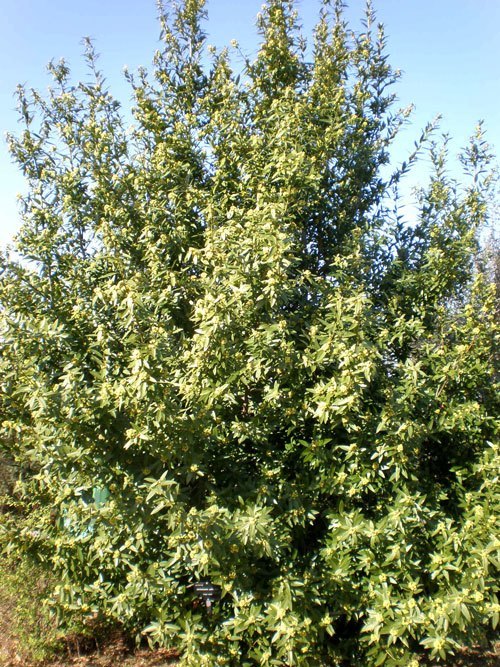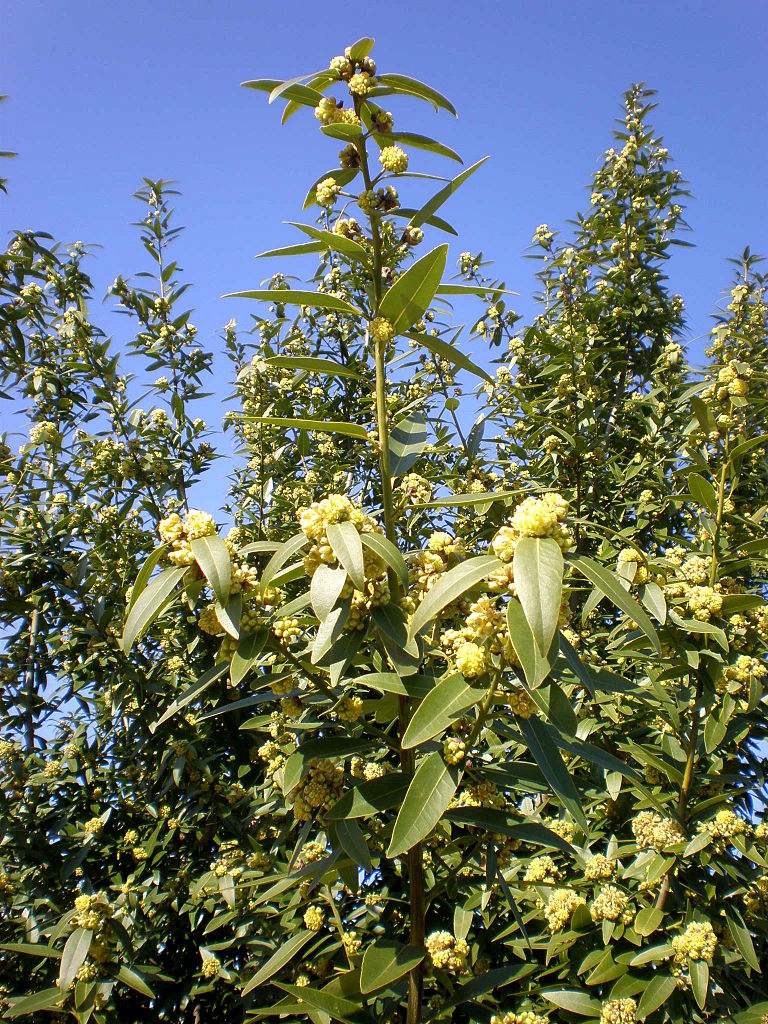Oregon Myrtle
Scientific Classification
| Kingdom: | Plantae |
| Genus: | Umbellularia |
| Family: | Lauraceae |
| Order: | Laurales |
| Species: | U. Califomica |
Oregon myrtle tree is also known as Umbellularia califomica. It is a large hardwood tree. In California it is the native tree in the coastal forest areas. It is formally known as an Oreodaphne Californica. In Oregon this tree is known as Oregon myrtle. Other names of this tree are pepper nut tree, cinnamon bush, Pepperwood, Mountain Laurel, Spicebush, Headache Tree And Balm Of Heaven. It is an evergreen tree. It is the largest tree in the California, Mendocino County. In height it measures about 108 feet and 119 feet in spread. It is the sacred tree of Aphrodite. It is also said in the Bible that this tree represents life and fertility. In Western Europe and in Vancouver in Canada it is used for firewood and considered a valuable tree. They may live about 200 years. In the early 1900s, this popular tree was used for making gift items. It is a handsome tree and it can grow in gardens and on the avenues. Its leaves have many toxic effects.
Anatomy
The leaves of Oregon myrtle tree are fragrant. They have smooth edges and are lance shaped. The leaves are aromatic, smooth and shiny. These are “bay” leaves. These leaves are 3 to 10 cm long and 1.5 to 3 cm broad. The flowers are small in size and yellow or yellowish green in color. These flowers are produced in small umbels. The fruit of this tree is known as “California bay nut”. It is round in shape and has green berries of 2 to 2.5 cm long and 2 cm broad. When the fruit matures it is purple and lightly spotted with yellow. The flowers bloom in the early spring and the late winter. The leaves have a similar flavor to bay leaves. This tree has the ability to grow again from the stump and it can also grow from seeds. Its root system is very strong which helps it in the regenerating the species in the wild. The flower of this tree occurs from the stem. Its fruits are round drupes. After flowering they ripen in the first autumn season. Each fruit of Oregon myrtle tree may contain a nut like a seed.
Habitat
Oregon myrtle tree is found in the yellow pine forests, redwood forests, California and in California mixed woods. In the forests, it grows tall and straight. It is also found in the southern and central California and in the western foothills of the Sierra Nevada mountains. It also occurs on the pacific coast of North America. Its yellow flowers, evergreen leaves and large yellow green fruits make it a good an ornamental tree. Breakage and damage of the branches and stems of this tree takes place due to the snow and the wind. Across its range, many tree species are associated with it. Those are Cottonwood, Willows, Red Alder, Tanoak, Pacific Madrone, Oregon Ash, Wax Myrtle, Sitka Spruce and Redwood. The common shrubs associated with this tree are Red Huckleberry, Evergreen Huckleberry, Salmon Berry, Poison Oak, Snow Berry, Honeysuckle, Service Berry and Dew Berry.
Growing at Home

Soil
Oregon myrtle tree can grow in many soil conditions. Well drained, fertile and moist soil is good for them. It can also grow on a wide variety of soils derived from sedimentary, alluvial and metamorphic material. It grows well on well-watered and deep soil, on coastal places, valley bottoms and on alluvial benches. In the home landscapes, it grows about 25 feet tall. It is grown for its decorative wood.
Uses
The Oregon myrtle tree has many uses. The leaves are used in the treatment of toothache, headache and earache. The leaves are used in the making of tea and this tea is used in the treatment of stomachache, clearing up mucus in the lungs, for sore throat and cold. The inner kernel and the flesh of the fruit of this tree are used by Native Americans as a food. The outer flesh of fruit is fleshy, and it is called mesocrap. When leaves are sniffed and crushed, the odor of its leaves cause headache and sneezing. This tree provides cover for many animals, and the seeds of the tree are very useful for wildlife. The seeds are used by mice, birds, squirrels and wood rats as a food. The wood of this tree is fine and hard. It is used in making gift items, salad bowls and spoons. They also use it to make cabinetry, Gunstock, veneer and paneling.
Care
Seeds of Oregon myrtle tree can be stored under moist and cool conditions. They should be planted immediately. Germination takes place in 3 months. A good, caring sunlight is ideal for them. Regular watering keeps it healthy. Establishment of tree from seed is good when the seed is fully covered by the soil. High Watering is also very necessary while planting by seed. In the spring season it requires pruning and also fertilizers. Extreme heat and sunlight is not good for them. To prevent the squirrel menace, mulching with pebbles is ideal for them.
Planting
The best conditions for growing of Oregon myrtle tree are lower slopes, protected bottomlands and moist and deep soil. These conditions are ideal for large trees. Dry and hot localities are also suitable. Its root system spreads wide depending on the drainage and the soil. This tree grows under the conditions that range from the humid and cold climate of the coastal forests to the dry and hot climate of the interior woodlands.
Pests
Oregon myrtle tree is attacked by a variety of pathogens. Pests do not cause any serious damage to the trees. By wind or snow its stem is stressed by stem canker. By decay fungi scarred or old trees are commonly invaded. Old bark beetles will attack the old trees. Ptilinus Basalis (Powder Post Beetles) seriously damage the stored logs or lumber. Volatile compounds of high concentration can reduce the incidents of damage due to pests.
Myrtle Wood

Photo by: Eugene Zelenko
The Oregon myrtle wood is well known for its diverse grain patterns and lovely colors, which make it one of the most attractive woods in the world.
Mostly, the soil minerals dictate the wood color, which is why it may be special to the Oregon coast. The wood colors are extraordinary, ranging from, blond, black, brown, honey shades and grays spiked with greens and reds.

Having discovered a fondness for insects while pursuing her degree in Biology, Randi Jones was quite bugged to know that people usually dismissed these little creatures as “creepy-crawlies”.







